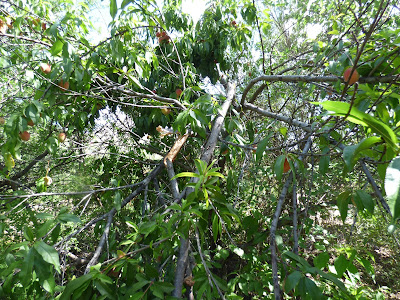I can't save the limbs, but maybe can save the peaches. They're still not ripe. I don't mind losing the limbs since they're hanging into the sitting area where birders watch activity in the mulberry trees in the spring. With the limbs removed I can put chairs under the tree where it's always been too crowded before. I should have propped the limbs up. Just too much to keep up with.
Still not much ode and butterfly activity. As for birds, just the nesting species. But there's plenty of work that needs doing before I go back to town tomorrow and start the apricot cycle again. The project I'm most dreading is getting into the stucco tank tomorrow to replace the broken line to the submersible pump. It's a rope that attaches to the pump so if you need to pull it out of the water you can. The pump is in the lowest part of the tank so even though the tank is real low, it might have as much as 3 foot of water where the pump is. The pump is heavy and I'll have to skid around in the underwater mud to get it dragged to shallower water, unless I'm able to attach the line in place. Don't expect photos. I can't take a camera into the water with me and no one else is here. It's good that I discovered it before the tank filled up with water. If the tank was full the pump would be under 12' of water. The shallow end of the tank is dry now, so it's basically that one puddle. Gonna rain one of these days.
This bee intrigued me today. It resembles the ones we had in Iowa, where I grew up, that we called "bumblebees." Not sure that's what this is, or not.
UPDATE: Brian says this is a bumblebee. Maybe with the non-native pollinators in decline these wonderful natives will make a comeback. First bumblebee I've seen at the oasis. I found this info online:
"While most everyone has heard at least something in the news about declining bees, most press coverage has been directed toward the plight of the non-native European honeybee. Very little attention is directed towards native bees, like bumblebees. Over the past few decades a substantial body of research has identified declines in bumblebee populations in Europe and North America.
Bumblebees have gone virtually unstudied in most states in this country despite their critical roles in agriculture and natural ecosystems. There is a real need to evaluate bumblebees in the United States to assess how their populations are faring and if conservation actions are needed."







No comments:
Post a Comment